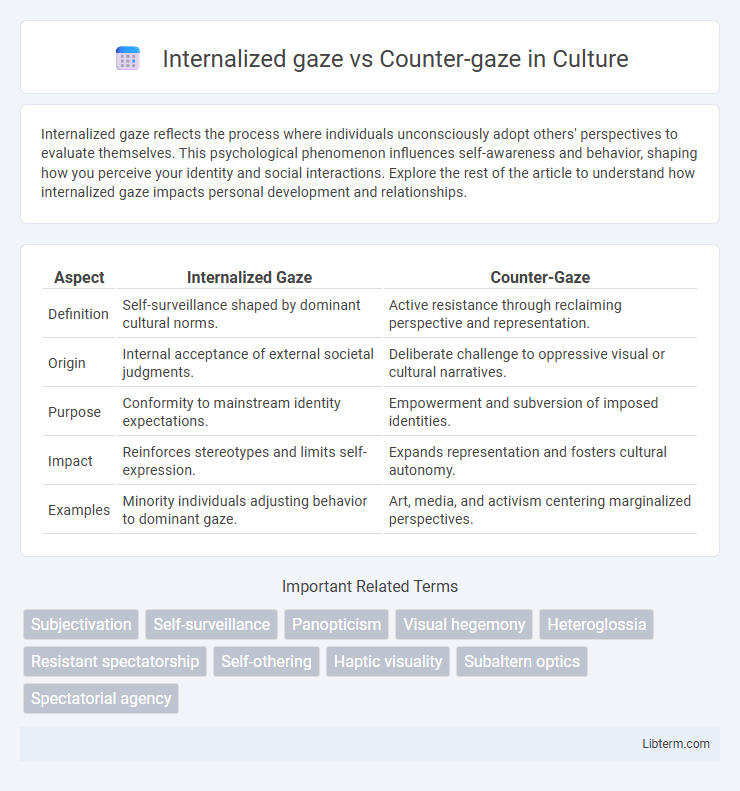Internalized gaze reflects the process where individuals unconsciously adopt others' perspectives to evaluate themselves. This psychological phenomenon influences self-awareness and behavior, shaping how you perceive your identity and social interactions. Explore the rest of the article to understand how internalized gaze impacts personal development and relationships.
Table of Comparison
| Aspect | Internalized Gaze | Counter-Gaze |
|---|---|---|
| Definition | Self-surveillance shaped by dominant cultural norms. | Active resistance through reclaiming perspective and representation. |
| Origin | Internal acceptance of external societal judgments. | Deliberate challenge to oppressive visual or cultural narratives. |
| Purpose | Conformity to mainstream identity expectations. | Empowerment and subversion of imposed identities. |
| Impact | Reinforces stereotypes and limits self-expression. | Expands representation and fosters cultural autonomy. |
| Examples | Minority individuals adjusting behavior to dominant gaze. | Art, media, and activism centering marginalized perspectives. |
Understanding the Concept of the Gaze
The concept of the gaze explores power dynamics and subjectivity through visual perception, where the internalized gaze reflects how individuals adopt societal or authoritative viewpoints, shaping self-identity and behavior. In contrast, the counter-gaze challenges dominant perspectives by reappropriating visual power to resist and redefine norms, often emerging in marginalized or subaltern contexts. Understanding these distinctions reveals how gaze theory articulates the interaction between observer and observed, emphasizing control, resistance, and identity construction.
Defining Internalized Gaze
Internalized gaze refers to the process by which individuals adopt and internalize the perspectives and judgments of dominant social groups, often shaping self-perception and identity unconsciously. This concept highlights how societal norms and power structures influence one's self-awareness and behavior through an internal mirror reflecting external gazes. Understanding internalized gaze is crucial in critical theory and cultural studies for analyzing the impact of hegemonic gaze on marginalized communities.
The Origins of Counter-Gaze
The origins of the counter-gaze emerge from feminist and postcolonial critiques challenging the dominant internalized gaze that objectifies and controls marginalized bodies. Rooted in the works of scholars like bell hooks and Laura Mulvey, the counter-gaze reclaims agency by reversing the power dynamics inherent in visual representation. This form of gaze subverts traditional voyeurism, enabling marginalized subjects to assert self-representation and resist oppressive stereotypes.
Psychological Effects of Internalized Gaze
Internalized gaze refers to the psychological process where individuals internalize an external perspective, often leading to self-surveillance and self-criticism that influence identity and behavior subconsciously. This internalization can result in increased anxiety, diminished self-esteem, and conformity to perceived societal expectations, impacting mental health and emotional well-being. In contrast to the counter-gaze, which challenges and subverts dominant viewpoints, the internalized gaze reinforces power dynamics by shaping how individuals perceive themselves through the lens of others.
Empowerment Through Counter-Gaze
The internalized gaze often represents the ingrained societal perspectives that shape individual identity and self-perception, frequently leading to self-surveillance and conformity. Counter-gaze, as a form of resistance, reclaims agency by challenging dominant narratives and enabling marginalized groups to redefine their own representations. Empowerment through counter-gaze occurs when individuals actively subvert entrenched power dynamics, using their perspective to assert visibility, autonomy, and social change.
Cultural Contexts: How the Gaze Operates
Internalized gaze reflects the way individuals perceive themselves through dominant cultural norms and power structures, often reinforcing existing societal hierarchies. Counter-gaze challenges these norms by reclaiming visual agency, allowing marginalized groups to resist objectification and assert alternative identities. Within diverse cultural contexts, the dynamics of gaze reveal how power operates visually, shaping identities and social relations through acts of seeing and being seen.
Internalized Gaze in Media and Representation
Internalized gaze in media refers to the process through which individuals absorb dominant societal perspectives and stereotypes, shaping their self-perception based on external judgments. This phenomenon often manifests in marginalized groups adopting the viewpoints of the prevailing culture, influencing identity formation and reinforcing power dynamics within representation. Understanding the internalized gaze is crucial for analyzing how media perpetuates inequalities by embedding hierarchical narratives into personal and collective identities.
Counter-Gaze as a Tool for Resistance
Counter-gaze serves as a critical tool for resistance by challenging and subverting the power dynamics embedded in the internalized gaze, which often enforces dominant cultural narratives and the objectification of marginalized subjects. This practice empowers individuals and communities to reclaim agency and redefine their representation, creating spaces for alternative perspectives and voices typically silenced or distorted by hegemonic observation. As a strategic act of seeing and being seen on one's own terms, counter-gaze disrupts oppressive visual regimes and fosters critical awareness, making it a potent mechanism for social and political resistance.
Navigating Identity Through Different Gazes
Navigating identity through the internalized gaze involves how individuals absorb and reflect societal perceptions, shaping self-awareness and conformity to external norms. The counter-gaze challenges these internalized views by asserting agency and resistance, allowing marginalized voices to redefine identity on their own terms. This dynamic interplay highlights the power structures embedded in visual culture and the ongoing negotiation between imposed identities and self-authored representations.
Future Directions: Reclaiming the Narrative
Future directions in addressing internalized gaze versus counter-gaze emphasize reclaiming the narrative through empowering marginalized voices and fostering critical self-awareness in cultural representation. Scholars advocate for integrating interdisciplinary methodologies that challenge dominant visual regimes and amplify subaltern perspectives in media and art. Emphasizing collaborative storytelling practices helps decolonize visual culture, enabling communities to assert autonomy over their own image production and interpretation.
Internalized gaze Infographic

 libterm.com
libterm.com